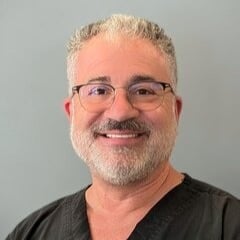For decades, avascular necrosis (AVN) of the femoral head was regarded as a degenerative...
Harnessing the Power of HBOT for Men's Health

Men's health encompasses the well-being of male patients, including physical and mental health components. Men's health is a crucial yet often underemphasized aspect of health care. Numerous studies have highlighted the unique health challenges faced by men, including higher rates of cardiovascular disease, certain types of cancer, and mental health issues. According to a study published in the National Library of Medicine, men tend to have a higher mortality rate and are less likely to seek medical attention compared to women.
With June being Men's Health Month, we want to suggest solutions to enhance men's health and well-being. In this article, we will explore the remarkable potential of Hyperbaric Oxygen Therapy (HBOT) in addressing common male health challenges and improving the overall quality of life.
Understanding Men's Health Challenges
The National Center for Health Statistics highlights several important facts about men's health. Overall, men have a higher mortality rate than women across all age groups, emphasizing the need for proactive health management. Secondly, men tend to have higher cardiovascular disease rates, including conditions like coronary artery disease and heart attacks. Additionally, there are male-specific types of cancer, such as prostate and testicular cancer. Mental health is another significant concern, as men experience higher rates of suicide and are less likely to seek help for mental health issues.
Hyperbaric Oxygen Therapy and its Potential Benefits for Men
Hyperbaric Oxygen Therapy (HBOT) has emerged as a powerful tool in men's health.HBOT involves breathing pure oxygen in a pressurized chamber, allowing for the absorption of significantly more oxygen into the tissues of the body. This increased oxygen supply can profoundly affect various health conditions that disproportionately affect men.
Cardiovascular Health
Cardiovascular disease remains a leading cause of morbidity and mortality among men. HBOT offers a promising approach to enhancing men's cardiovascular health by improving cardiac function and reducing tissue damage. HBOT improves blood flow, enhances tissue oxygenation, promotes the growth of new blood vessels, and can improve left ventricular function. These effects can aid in recovering and rehabilitating individuals who have suffered from heart attacks, strokes, or other cardiovascular events.
Erectile Dysfunction
Erectile dysfunction (ED) is a common condition that affects many men and can significantly impact their quality of life. HBOT has demonstrated promising results in improving erectile function by enhancing blood flow, promoting tissue regeneration, and improving vascular health. This improvement can help restore erectile function, providing men with renewed confidence and rebuilding intimacy with their partners.
Mental Health and Well-being
Depression, anxiety, and other mental health conditions are prevalent among men but can go unnoticed or untreated. HBOT offers a potential therapeutic approach for improving mental health outcomes. By reducing inflammation in the brain, promoting neuroplasticity, and enhancing overall brain function, HBOT has shown promise in alleviating symptoms of depression, anxiety, and post-traumatic stress disorder. It provides men with an adjunctive, non-pharmaceutical option for mental health support and an opportunity to enhance their overall well-being.
Cancer and Radiation-Induced Tissue Damage in Men
Cancer is a disease that affects both men and women, but certain types of cancer only develop in men's reproductive system, such as prostate and testicular cancer. There have been significant advancements in cancer treatments that offer promising outcomes to patients, including radiation therapy. However, some patients may have some negative long-term effects from these therapies.
Radiation-Induced Tissue Damage:
Radiation therapy is a standard treatment option for some types of cancer. While it can effectively target and destroy cancer cells, it can also cause collateral damage to surrounding healthy tissues. For example, men undergoing radiation therapy for prostate cancer may experience tissue damage in the pelvic region, leading to complications such as erectile dysfunction, urinary bleeding and incontinence, and bowel problems.
HBOT and Radiation-Induced Tissue Damage:
Hyperbaric Oxygen Therapy (HBOT) has been recognized as a valuable adjunctive treatment for radiation-induced tissue damage. By delivering high levels of oxygen to damaged tissues, HBOT promotes healing, reduces inflammation, and stimulates tissue regeneration. The increased oxygen supply helps mitigate the harmful effects of radiation, enhancing the body's natural healing processes and minimizing long-term side effects. In the case of prostate cancer, studies have demonstrated that HBOT can improve erectile function by enhancing blood flow, promoting tissue repair, and reducing fibrosis caused by radiation therapy.
HBOT has shown promising results in addressing radiation-induced tissue damage in various areas of the body. In the case of prostate cancer, studies have demonstrated that HBOT can improve erectile function by enhancing blood flow, promoting tissue repair, and reducing fibrosis caused by radiation therapy. It offers hope and potential solutions for men experiencing the detrimental effects of radiation treatment.
Cancer Survivorship and Quality of Life:
Beyond the physical challenges, cancer and its treatment can significantly impact a man's emotional well-being and overall quality of life. Survivors may experience fatigue, anxiety, depression, and other psychological and emotional difficulties. HBOT has been found to alleviate fatigue symptoms by increasing energy levels, improving oxygen delivery to tissues, and enhancing overall cellular function. By addressing both the physical and emotional aspects of cancer survivorship, HBOT can improve men's quality of life post-treatment.
Sports Injuries and Recovery:
Men are often engaged in high-impact activities and sports, making them more prone to sports-related injuries. HBOT can play a supporting role in accelerating the healing process for conditions such as muscle strains and contusions, ligament injuries, and stress fractures. By promoting tissue repair, reducing inflammation, and enhancing oxygenation in the injured area, HBOT can help men recover faster and return to their active lifestyles with improved outcomes.
Sports injuries also include traumatic brain injuries and concussions. Hyperbaric Oxygen Therapy (HBOT) has shown promise in the treatment of traumatic brain injuries and concussions. The increased oxygen levels delivered during HBOT sessions have been found to reduce inflammation, promote neurogenesis (the growth of new brain cells), and enhance brain function. By improving the oxygen supply to the brain, HBOT supports the healing and recovery process after a TBI.
Conclusion
There are health challenges that are unique to men. Men's health focuses on improving preventative screening, promoting healthy behaviors, and optimizing treatment for the serious conditions men face. The remarkable potential of Hyperbaric Oxygen Therapy (HBOT) offers an innovative approach to improving men's health and well-being. From cardiovascular health to sports injuries, erectile dysfunction, and mental health concerns, HBOT has shown promise in addressing common male health challenges. As we celebrate Men's Health Month, let us recognize the importance of proactive health management and explore the transformative power of HBOT in optimizing men's quality of life. By embracing these innovative solutions, we can empower men to take control of their health and thrive in all aspects of their lives.
As we celebrate Men's Health Month, let us recognize the importance of proactive health management and explore the transformative power of HBOT in optimizing men's quality of life. By embracing these innovative solutions, we can empower men to take control of their health and thrive in all aspects of their lives.
See if Hyperbaric Oxygen Therapy is Right For You
References:
- Leitman M, Efrati S, Fuchs S, Hadanny A, Vered Z. The effect of hyperbaric oxygenation therapy on myocardial function. Int J Cardiovasc Imaging. 2020;36(5):833-840. doi:10.1007/s10554-020-01773-0
- Hadanny, A., Lang, E., Copel, L. et al. Hyperbaric oxygen can induce angiogenesis and recover erectile function. Int J Impot Res 30, 292–299 (2018). https://doi.org/10.1038/s41443-018-0023-9
- Doenyas-Barak K, Catalogna M, Kutz I, Levi G, Hadanny A, et al. (2022) Hyperbaric oxygen therapy improves symptoms, brain’s microstructure and functionality in veterans with treatment resistant post-traumatic stress disorder: A prospective, randomized, controlled trial. PLOS ONE 17(2): e0264161. https://doi.org/10.1371/journal.pone.0264161
- Nicklas Oscarsson, Bernd Müller, Anders Rosén, Pär Lodding, Johan Mölne, Daniel Giglio, Karin M Hjelle, Guro Vaagbø, Ole Hyldegaard, Michael Vangedal, Lisbeth Salling, Anders Kjellberg, Folke Lind, Otto Ettala, Olli Arola, Helén Seeman-Lodding,
- Radiation-induced cystitis treated with hyperbaric oxygen therapy (RICH-ART): a randomised, controlled, phase 2–3 trial,
- The Lancet Oncology,Volume 20, Issue 11,2019,Pages 1602-1614,ISSN 1470-2045,https://doi.org/10.1016/S1470-2045(19)30494-2.
- Feldmeier JJ. Hyperbaric oxygen for radiation cystitis. The lancet oncology. 2019;20(11):1481-1482. doi:10.1016/S1470-2045(19)30574-1
- Velure GK, Müller B, Hauken MA. Symptom burden and health-related quality of life six months after hyperbaric oxygen therapy in cancer survivors with pelvic radiation injuries. Support Care Cancer. 2022 Jul;30(7):5703-5711. doi: 10.1007/s00520-022-06994-8. Epub 2022 Mar 23. PMID: 35320424; PMCID: PMC9135809.
- Harch PG. Systematic Review and Dosage Analysis: Hyperbaric Oxygen Therapy Efficacy in Mild Traumatic Brain Injury Persistent Postconcussion Syndrome. Frontiers in neurology. 2022;13:815056-815056. doi:10.3389/fneur.2022.815056

Written by Alan Katz, MD, FUHM, FACEP, FAAEM
Dr. Alan Katz, National Medical Director of Hyperbaric Medical Solutions (HMS), is double board certified in Emergency Medicine and Hyperbaric Medicine. He directs clinical operations, education and research initiatives, and the integration of other regenerative medicine therapies....
Read More



